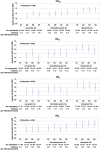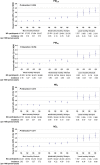Genetic susceptibility and lifestyle modify the association of long-term air pollution exposure on major depressive disorder: a prospective study in UK Biobank
- PMID: 36810050
- PMCID: PMC9945634
- DOI: 10.1186/s12916-023-02783-0
Genetic susceptibility and lifestyle modify the association of long-term air pollution exposure on major depressive disorder: a prospective study in UK Biobank
Abstract
Background: Evidence linking air pollution to major depressive disorder (MDD) remains sparse and results are heterogeneous. In addition, the evidence about the interaction and joint associations of genetic risk and lifestyle with air pollution on incident MDD risk remains unclear. We aimed to examine the association of various air pollutants with the risk of incident MDD and assessed whether genetic susceptibility and lifestyle influence the associations.
Methods: This population-based prospective cohort study analyzed data collected between March 2006 and October 2010 from 354,897 participants aged 37 to 73 years from the UK Biobank. Annual average concentrations of PM2.5, PM10, NO2, and NOx were estimated using a Land Use Regression model. A lifestyle score was determined based on a combination of smoking, alcohol drinking, physical activity, television viewing time, sleep duration, and diet. A polygenic risk score (PRS) was defined using 17 MDD-associated genetic loci.
Results: During a median follow-up of 9.7 years (3,427,084 person-years), 14,710 incident MDD events were ascertained. PM2.5 (HR: 1.16, 95% CI: 1.07-1.26; per 5 μg/m3) and NOx (HR: 1.02, 95% CI: 1.01-1.05; per 20 μg/m3) were associated with increased risk of MDD. There was a significant interaction between the genetic susceptibility and air pollution for MDD (P-interaction < 0.05). Compared with participants with low genetic risk and low air pollution, those with high genetic risk and high PM2.5 exposure had the highest risk of incident MDD (PM2.5: HR: 1.34, 95% CI: 1.23-1.46). We also observed an interaction between PM2.5 exposure and unhealthy lifestyle (P-interaction < 0.05). Participants with the least healthy lifestyle and high air pollution exposures had the highest MDD risk when compared to those with the most healthy lifestyle and low air pollution (PM2.5: HR: 2.22, 95% CI: 1.92-2.58; PM10: HR: 2.09, 95% CI: 1.78-2.45; NO2: HR: 2.11, 95% CI: 1.82-2.46; NOx: HR: 2.28, 95% CI: 1.97-2.64).
Conclusions: Long-term exposure to air pollution is associated with MDD risk. Identifying individuals with high genetic risk and developing healthy lifestyle for reducing the harm of air pollution to public mental health.
Keywords: Air pollution; Genetic susceptibility; Healthy lifestyle; Interaction; Major depressive disorder.
© 2023. The Author(s).
Conflict of interest statement
The authors declare that they have no competing interests.
Figures



Similar articles
-
Air Pollution, Genetic Factors, and the Risk of Lung Cancer: A Prospective Study in the UK Biobank.Am J Respir Crit Care Med. 2021 Oct 1;204(7):817-825. doi: 10.1164/rccm.202011-4063OC. Am J Respir Crit Care Med. 2021. PMID: 34252012
-
Exposure to Air Pollution, Genetic Susceptibility, and Psoriasis Risk in the UK.JAMA Netw Open. 2024 Jul 1;7(7):e2421665. doi: 10.1001/jamanetworkopen.2024.21665. JAMA Netw Open. 2024. PMID: 39012635 Free PMC article.
-
Ambient air pollution, healthy diet and vegetable intakes, and mortality: a prospective UK Biobank study.Int J Epidemiol. 2022 Aug 10;51(4):1243-1253. doi: 10.1093/ije/dyac022. Int J Epidemiol. 2022. PMID: 35179602 Free PMC article.
-
Association between exposure to ambient air pollution and hospital admission, incidence, and mortality of stroke: an updated systematic review and meta-analysis of more than 23 million participants.Environ Health Prev Med. 2021 Jan 26;26(1):15. doi: 10.1186/s12199-021-00937-1. Environ Health Prev Med. 2021. PMID: 33499804 Free PMC article.
-
Short-term exposure to particulate matter (PM10 and PM2.5), nitrogen dioxide (NO2), and ozone (O3) and all-cause and cause-specific mortality: Systematic review and meta-analysis.Environ Int. 2020 Sep;142:105876. doi: 10.1016/j.envint.2020.105876. Epub 2020 Jun 23. Environ Int. 2020. PMID: 32590284
Cited by
-
Linking ambient air pollution to mental health: evidence based on the two-sample Mendelian randomization and colocalization study.Transl Psychiatry. 2024 Dec 18;14(1):489. doi: 10.1038/s41398-024-03196-0. Transl Psychiatry. 2024. PMID: 39695075 Free PMC article.
-
Effects of polygenic risk for major depressive disorder and childhood emotional neglect on cortical blood flow complexity in young depression patients.Brain Imaging Behav. 2025 Jun;19(3):713-720. doi: 10.1007/s11682-025-00983-1. Epub 2025 Apr 2. Brain Imaging Behav. 2025. PMID: 40169478
-
Interaction between the oxidative balance score and serum per- and poly-fluoroalkyl substances (PFASs) on liver health: analysis of the NHANES 2007-2018 dataset.Environ Health Prev Med. 2024;29:51. doi: 10.1265/ehpm.24-00159. Environ Health Prev Med. 2024. PMID: 39358301 Free PMC article.
-
Education counteracts the genetic risk of Alzheimer's disease without an interaction effect.Front Public Health. 2023 Aug 17;11:1178017. doi: 10.3389/fpubh.2023.1178017. eCollection 2023. Front Public Health. 2023. PMID: 37663829 Free PMC article.
-
Associations between air pollution and surrounding greenness with internalizing and externalizing behaviors among schoolchildren.Child Adolesc Ment Health. 2025 May;30(2):149-158. doi: 10.1111/camh.12772. Epub 2025 Mar 21. Child Adolesc Ment Health. 2025. PMID: 40114503 Free PMC article.
References
-
- WHO: World Health Organization . The Global Burden of Disease: 2004 Update. 2008.
MeSH terms
Substances
LinkOut - more resources
Full Text Sources
Medical

